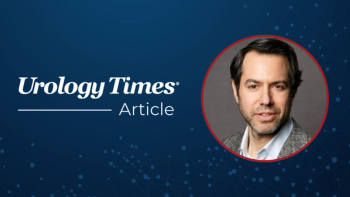
Treatment Strategies for BCG-Unresponsive NMIBC
This video episode discusses various new therapies and strategies for treating patients with high-risk BCG-unresponsive NMIBC. It includes a review of nadofaragene firadenovec-vncg, its FDA approval, dosing schedule, and patient response rates. The conversation also explores the practical aspects of treatment, such as the balance between efficacy and treatment frequency, and the potential sequencing of therapies in clinical practice.
Episodes in this series

This is a synopsis of the Viewpoints video series featuring moderator, Sam S. Chang, MD, MBA, from Vanderbilt University School of Medicine, and panelists Gary Steinberg, MD, FACS, from Rush University Medical Center, Mark Tyson, MD, of Mayo Clinic Phoenix, Roger Li, MD, from Moffitt Cancer Center, and Sandip M. Prasad, MD, MPhil, of Morristown Medical Center.
Episode 10 focuses on innovative therapies and strategies for managing high-risk Bacillus Calmette-Guérin (BCG)-unresponsive non-muscle invasive bladder cancer (NMIBC). The panel of experts reviews treatments like nadofaragene firadenovec (Adstiladrin), discussing its FDA approval, dosing schedule, and patient response rates. The conversation also addresses practical aspects of treatment, balancing efficacy and frequency, and potential sequencing of therapies in clinical practice. The panelists highlight the importance of adstiladrin (nadofaragene firadenovec), an FDA-approved therapy for high-risk BCG-unresponsive NMIBC with carcinoma in situ (CIS), with or without papillary tumors. Noted for its quarterly dosing schedule, adstiladrin (nadofaragene firadenovec) has been well-received by patients due to its tolerability and logistic convenience, despite the desire for higher complete response rates. The panelists acknowledge the challenges in treating this heavily pretreated CIS population.
The discussion also touches on the management of BCG-naïve diseases and the high standards required to surpass BCG's effectiveness. Panelists point out the prevalent use GEMDOCE regimen (combination of intravesical gemcitabine and docetaxel chemotherapy) in clinical practice, particularly its efficacy and tolerability, despite the logistics involved in administering these sequential installations. The experts delve into the complexities of treating BCG-unresponsive patients, considering the weighing of efficacy against the morbidity of frequent treatments. They discuss the prospect of using chemotherapy agents, like those in the phase 3 BRIDGE trial (intravesical BCG vs intravesical docetaxel and gemcitabine in BCG-naïve high grade NMIBC) as de facto standards for BCG-unresponsive patients. They also emphasize the importance of sequencing treatments based on toxicity and efficacy, and the potential use of biomarkers for better patient response prediction. The panelists discuss the necessity of personalized treatment, considering various factors such as patient age, tumor characteristics, and previous treatments. They acknowledge the growing interest in new treatments and the emerging data that suggest it's rare for patients to progress to muscle invasive disease immediately after developing BCG-unresponsive disease.
In summary, Episode 10 provides an insightful overview of new therapies and strategies for BCG-unresponsive NMIBC, highlighting the critical need for personalized treatment plans and the careful sequencing of therapies. The episode underscores the importance of considering both efficacy and patient burden in treatment selection, as well as the potential for utilizing biomarkers in clinical practice.
*Video synopsis is AI-generated and reviewed by Urology Times® editorial staff.
Newsletter
Stay current with the latest urology news and practice-changing insights — sign up now for the essential updates every urologist needs.




















